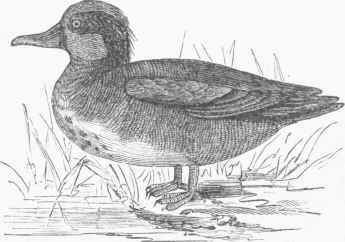Teal
Description
This section is from "The American Cyclopaedia", by George Ripley And Charles A. Dana. Also available from Amazon: The New American Cyclopędia. 16 volumes complete..
Teal
Teal, the common name of the small river ducks of the genera nettion (Kaup) and querquedula (Stephens), called sarcelles by the French. In the genus nettion the bill is as long as the head, straight, unusually narrow, with sides parallel, as high as broad at the base, the depressed tip with a very narrow nail; wings moderate and pointed, second quill the longest, and the secondaries lengthened and pointed; tail moderate and wedge-shaped; toes united by a full web, the hind one short and slighty lobed. There are about 20 species, distributed all over the globe, though most numerous in the northern hemisphere; they are migratory, commencing their rapid flights in small flocks soon after sunset, resting by day on the surface of fresh water or the reedy shores of rivers and lakes, and feeding principally at. night on aquatic insects and worms, seeds, and grains; the nest is made of a large mass of decayed vegetable matter lined with down, and the eggs are eight to ten; they are highly esteemed as game.
The European teal was domesticated by the Romans. The green-winged teal (N. Carolinensis, Baird) is 14 in. long, 22 to 24 in. in alar extent, and the bill 1 2/8 in.; the head and neck are chestnut, the chin black, and the forehead dusky; around the eyes and on the sides of the head is a broad rich green stripe, passing into a bluish black patch on the nape; below white, with rounded black spots on throat; lower neck, sides, and scapulars finely banded with black and grayish white; speculum on wings broad and rich green; a white crescent in front of bend of wings; under tail coverts black, with a patch of buff white on each side; wing coverts plain olive-gray; in the female the under parts are white, and the upper dark brown with gray edgings. It occurs over the whole of North America, and accidentally in Europe; it migrates principally over the land, breeding from the great lakes to the fur countries; it runs well, is a good swimmer and diver, and a very rapid and graceful flier; having a comparatively long neck, it feeds while swimming, and, being choice in its selection of food, affords a delicious flesh; it is not very shy; the eggs are 1¾ by 1⅜ in., much rounded, dull yellowish with indistinct deeper tints. - In the genus querque-dula the bill widens a little to the end, which is obtusely rounded, is higher than broad at base, has a wider nail and the lamellae visible on the sides.
There are about half a dozen species in North America, Europe, and Asia, with habits similar to those of the other genus. The blue-winged teal (Q. discors, Steph.) is 16 in. long, 24 or 25 in. in alar extent, with a bill of 1⅞ in.; the head and neck above are plumbeous gray; top of head black; .white crescent in front of eyes; under parts purplish gray, each feather spotted with black; fore part of back brownish with two narrow bands of purplish gray; back behind and tail greenish brown; under tail coverts black; outer webs of some of the scapulars and the wing coverts bright blue; greater coverts tipped with white, with grass-green speculum below them; bill black; in the female the top of the head is brown, chin and throat yellowish white, back brown with paler edgings, under parts whitish with obscure brown spots, and the same blue and white in the wings as in the male. It is found throughout eastern North America to the Rocky mountains, is abundant about the mouths of the Mississippi in winter, and is less hardy than the green-winged species.

Green-winged Teal (Nettion Carolinensis).
Continue to:


